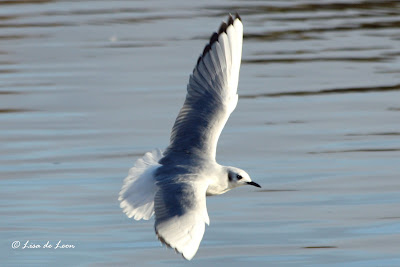I followed along the shore to the south side of the lake to get a better look and was able to get good views of this bird in flight. During this time, the third good thing happened. The sun popped out! I was afraid the gulls might go quickly so I didn't take the time to change the settings on my camera to accommodate the sun. That was a bad move on my part because most of the following pictures look washed out.
By the time I got around the lake, the Bonaparte's flew right in on cue and landed right in front of me.
As you can guess, all of this happened very quickly, and I kept shooting. Now there were two. Both of these gulls are already into their Winter plumage, although one of them had more dark markings than the other.
These gulls were not afraid of humans. This one swam straight over to me. I wonder where it was before it came to QV?
Still bold and confident, it came right up to shore and rested on the water's edge for a little while.
As you can tell by the differences in colors of all of these shots, the sun and clouds were doing all kinds of tricks with my photography. It is impossible to set the camera and expect to shoot for even 5 minutes without a lighting change. That is just the weather in St. John's. As I check through my gull list, I find that this is my 13th gull species to see on the Avalon Peninsula, including the Black-legged Kittiwakes. During my outings last year, I never saw a Bonaparte's. That makes for a special beginning to the gull season for me this year.
 Updated: January 9, 2011. On New Year's Day I took a spin around to several of the known bird locations. Among them is Pier 17 where many rare gulls have been sighted. On this day as most days this winter, a small Bonaparte's Gull was fishing for food.
Updated: January 9, 2011. On New Year's Day I took a spin around to several of the known bird locations. Among them is Pier 17 where many rare gulls have been sighted. On this day as most days this winter, a small Bonaparte's Gull was fishing for food. Although I saw two Bonaparte's together in October, no two have been sighted in the same place again. This one seems to be spending the winter with the Black-headed and Iceland Gulls. Despite its small size, it holds its own when foraging for food.
This bird is similar to the Black-headed Gulls except: 1) It is smaller 2) Its beak is black, not red/orange and 3) Its legs are much lighter in color than the Black-headed Gull.








